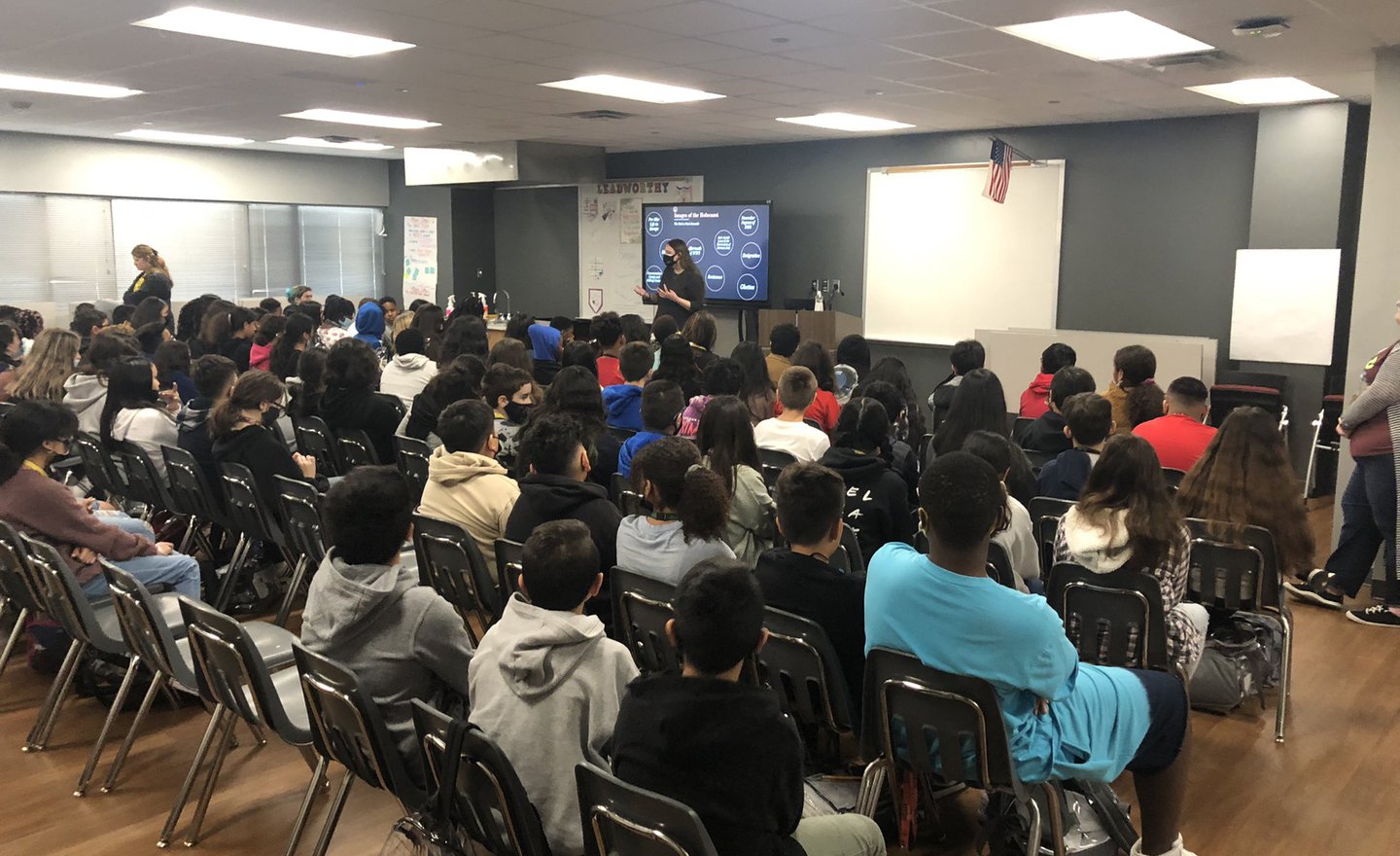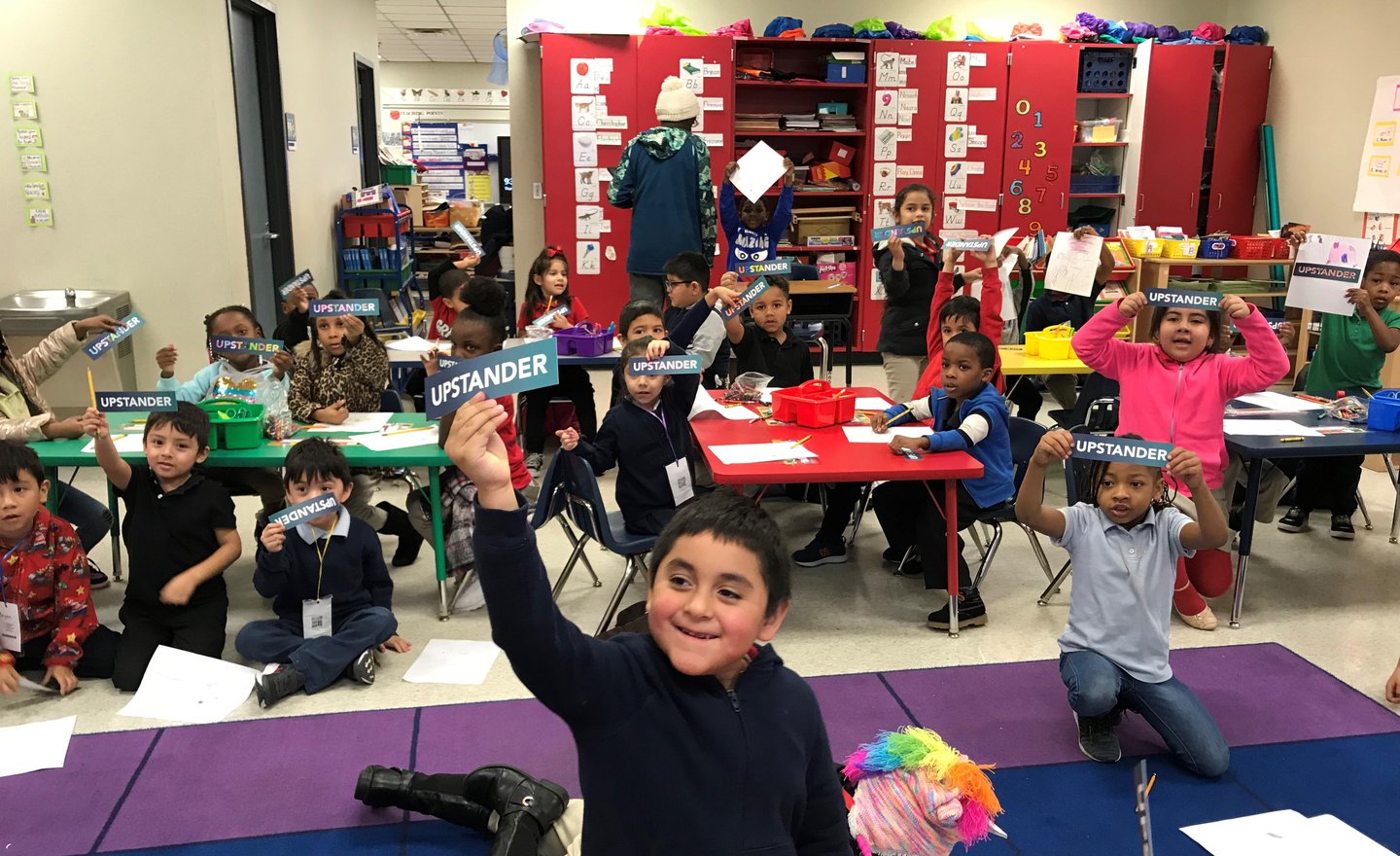The Educator in Motion program (EIM) is a FREE initiative that sends museum educators to school and community groups to provide educational programming on the Holocaust, human rights, and active citizenship.
Integrating social studies, language arts, and fine arts concepts, EIM programs enhance student content knowledge and critical thinking skills while supporting the development of individual and civic responsibility in K-12 classrooms. Students work directly with a museum educator and participate in interactive activities that explore the lessons of the Holocaust, human rights throughout history, and the role of individuals in society today.
Each Educator in Motion program is designed to be presented in a class period and can be adapted to fit your classroom schedule. We can visit your campus for each class period all day, a single class period, or anything in between. Programs can be adapted to work with one or more classes at a time – there are no minimum or maximum requirements for number of participants.
All EIM programs can be presented in English or Spanish and are in alignment with Texas Essential Knowledge and Skills (TEKS) standards.
In person programs are available throughout the Greater Houston Area. Virtual versions of all our programs are available to schools and community groups across the United States.
For more information or to schedule a program for your campus, please email education@hmh.org or call 713-527-1606.
The Educator in Motion program would like to thank the following donors for their generous support: Arline Guefen Endowment Fund, Bank of Texas, Cyvia and Melvyn Wolff Family Foundation, Frances and Louis Gordon Endowment Fund, Jake and Nina Kamin Educational Outreach Endowment Fund, Jerry Rochman, Nicole and Glenn Lowenstein Educator in Motion Education Endowment, Polly & David Roth Education Endowment Fund, The Powell Foundation, and Ronald Grabois Family Fund.
2022-2023 PROGRAM OPTIONS

Photo Credit: Watkins Middle School
MIDDLE/HIGH SCHOOL PROGRAMS (GRADES 6 – 12)
Images of the Holocaust
Through analysis of primary sources such as photographs, maps, and political cartoons, students explore a historical overview of the Holocaust from the Treaty of Versailles to the end of World War II. This program is best suited for students with limited to moderate knowledge of the Holocaust and is appropriate for grades 6–12.
Personal Narratives of the Holocaust
Through diaries and video testimony, students discover the personal stories and experiences of Jewish people during the Holocaust. This program is best suited for students with limited to moderate knowledge of the Holocaust and is appropriate for grades 6–12.
The Jewish Refugee Crisis and the World’s Response
Students examine the obstacles and challenges of Jewish emigration under the Nazi regime and the ensuing refugee crisis prior to the outbreak of WWII with a particular focus on U.S. policy. This program includes an activity in which students explore the response of the United States to the Jewish refugee crisis using political cartoons from the 1930s. This program is best suited for students who understand the core facts of the Holocaust and is appropriate for grades 6 –12.
The Possibility of Individual Choice: Upstanders during the Holocaust
Students explore stories of rescue and resistance during the Holocaust and the courageous individuals whose actions saved lives during a time of injustice. This program is best suited for students who understand the core facts of the Holocaust and is appropriate for grades 5–12.
Art of the Holocaust
Through the analysis and interpretation of artwork created by Jewish artists living under the Nazis, students consider the role of art during times of injustice and how these visual voices shed light on the personal experiences of Jewish people during the Holocaust. This program uses an image analysis strategy to guide students in a deep exploration of art pieces covering the major events of the Holocaust. This program can be tailored for students with limited to extensive knowledge of the Holocaust and is appropriate for grades 6–12.
Teen Leadership: Lessons from the Holocaust
Utilizing primary sources, students explore case studies of individual decision-making before and during the Holocaust to prompt discussion about bullying, individual behavior, and active citizenship. Students consider their own responsibilities and choices and the power of individuals to make change. This program is best suited for students who understand the core facts of the Holocaust and is appropriate for grades 6–12.
Contemporary Genocides
Beginning with a historical overview of genocides prior to the Holocaust, students examine and analyze the United Nation’s Genocide Convention as well as the advantages and challenges of this document. This program includes an interactive activity in which students investigate case studies of atrocities after the Holocaust and determine if a genocide occurred there according to the UN Genocide Convention. This program is appropriate for grades 9-12. Please note: portions of the case studies can be graphic in nature given the subject matter.
Human Rights
Students are introduced to the evolution of human rights throughout history and the development of the Universal Declaration of Human Rights in the aftermath of the Holocaust. Through interactive activities, students identify the importance of human rights, explore the difference between rights and laws, and meet Upstanders who have promoted human rights around the world. This program is appropriate for grades 6-12.

“Building Upstanders” | Photo Credit: de Santiago EC/PK & Head Start Center
ELEMENTARY SCHOOL PROGRAMS (GRADES PRE-K – 5)
Standing Up to Bullying
In the Standing Up to Bullying program (previously called All Behaviors Count), students consider the impact of bullying on their classmates, school, and community. Through interactive discussions, videos, and activities, students learn to identify harmful behaviors, develop strategies to help them intervene as empowered Upstanders, and brainstorm actions they can take to build positive and inclusive communities. This program is appropriate for grades Pre-K-5.
Change Makers: Upstanders in American History
Using children’s literature, participants discover the stories of Upstanders in American history who used their voices to promote equality, justice, and respect for all. Change Makers include Dolores Huerta, Rosa Parks, Audrey Faye Hendricks, Cesar Chavez, Elizabeth Cady Stanton, Sylvia Mendez, Raven Wilkinson, Jennifer Keelan-Chaffins, and other social justice advocates who stood up for equal rights. This program includes an art project in which students create their own “sensory figure,” an activity that supports literacy and social studies skills, to review and present on what they learned. This program is best suited for grades 3-5.
Building Upstanders
Through readings and guided discussion, students examine the powerful impact kindness, empathy, and inclusion can have and the importance of using our voices to stand up for others. This program includes an art project in which students brainstorm actions they can take to become an Upstander. This program is best suited for grades Pre-K-3.